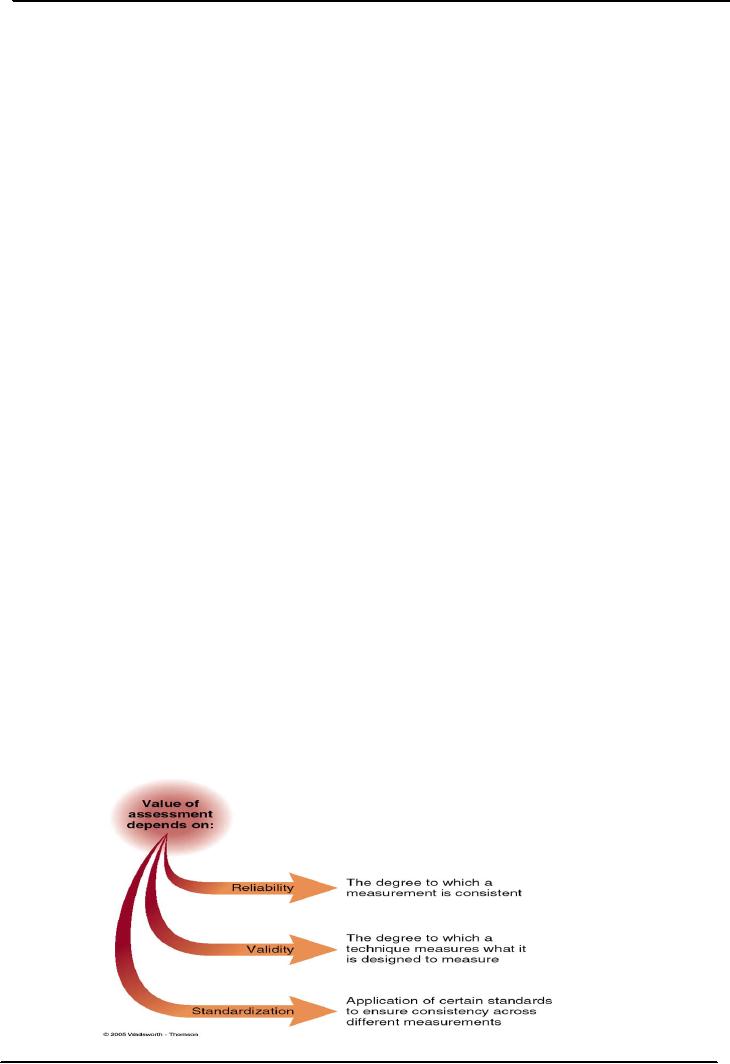 |
DIAGNOSIS & ASSESSMENT:Assessment Techniques, Observation |
| << COMMUNITY COUNSELING & CONSULTING:Community Counseling |
| FINAL OVERVIEW:Ethical issues, Influencing skills, Counseling Approaches >> |

Theory
and Practice of Counseling -
PSY632
VU
Lesson
44
DIAGNOSIS
& ASSESSMENT
The
DSM-IV Multiaxial
Assessment
The
fourth edition of the Diagnostic and
Statistical Manual of Mental
Disorder (DSM-IV), published by
the
American
Psychiatric Association in 1994, is basic
instrument in making and reporting formal
mental
diagnosis
all over the world. It has
gone through 5 revisions
since it was published first time. A
text revision
of
DSM-IV (DSM-IV-TR) was published in
2000. The DSM-IV attracts
controversy and criticism as well
as
praise.
The major advantage of DSM-IV is
its multiaxial system
divided into five
Axes:
Axis
I Major clinical disorders
Axis
II Stable, enduring problems
Axis
III Medical conditions related to
abnormal behavior
Axis
IV Psychosocial problems
Axis
V Global clinician rating of
adaptive functioning
Following
are the main characteristics of
DSM-IV:
�
Five
axes describe full clinical
presentation.
�
Clear
inclusion and exclusion criteria have
been described for
disorders.
�
Disorders
are categorized under broad
headings.
�
Empirically
grounded prototypic approach to
classification is adopted.
�
The
major advantage in using this multiaxial
classification system is that it
ensures that attention
is
given
to certain types of disorders,
aspects of the environment and
areas of functioning that
might
he
overlooked if the focus were on
assessing a single presenting
problem.
�
In
addition to diagnosing the client as to
mental health, personality disorders, and
physical
condition,
scales have been developed to
help the clinician make consistent
determinations of the
severity
of the psychosocial stressors (Axis IV)
and the global assessment of functioning
(GAF)
(Axis
V). When using the GAP on
Axis V, the clinician should record a current
determination and
an
estimate of the highest GAF
for the past year.
�
Thus,
rather than give a one- or two-word label
to a diagnosed person, such as
"depressive
neurosis,"
as was the practice prior to the
adoption of the DSM , the practitioner
now can come up
with
a diagnosis such as the
following:
DSM-IV:
An Example
Axis
I: 296.24 Major depression,
single episode; severe
without psychotic
features
Axis
II: 301.60 Dependent personality
disorders
Axis
III: Diabetes
Axis
IV: Psychosocial stressors: separated
from spouse; conflicts with
children
Axis
V: Current GAF = 44 Highest GAF
past year = 55
Use
of Tests: A Controversial
Issue
Among
the ranks of counseling professionals,
there also has been a
great deal of controversy related to
the
nature
and appropriateness of assessment
and diagnosis. Leo Goldman,
an expert in the use of tests in
counseling,
indicates that "there is
increased feeling that the use of
tests in counseling on the whole is a
sad
disappointment
and that in recent years
matters have actually become
worse" (Leo Goldman, 1972,
p. 213).
However,
a full understanding of assessment
concepts and practices is
necessary whether or not
counselors
choose
to use tests and other
diagnostic instruments. It is necessary
to communicate with those
who do use
these
tools in case conferences, referrals,
and correspondence, as well as to
understand the professional
literature.
190

Theory
and Practice of Counseling -
PSY632
VU
Sugarman
(1978) points out that the
objections to the use of assessment and
appraisal techniques are
based
on
five different
grounds:
�
It is
reductionistic, reducing the complexity of the
person into diagnostic
categories.
�
It is
artificial.
�
It
ignores the quality of the relationship
between the examiner and the
test taker.
�
It
judges people, casting a label on
them.
�
It is
overly intellectual, relying on complex
concepts, often at the expense of a true
understanding
of
the individual.
Businesses
and industries have used
tests and inventories for
many years as primarily aids
in the selection of
job
candidates. Testing has been
and continues to be a general
accepted function in mental health
centers,
employment
offices, and other private
public clinics and agencies.
Tests and their use
have not changed
significantly
since objections were raised in
1970s and earlier. Basically, what
seems to have changed is
the
overall
attitude of people toward tests.
Recent Gallup polls of the U.S.
population indicate a general
acceptance
in the use of standardized tests. In
Pakistan also, people feel more
satisfied as clients if tests
are
used
for assessing their
psychological problems or for
career counseling. Assessment
procedures of all
types
are
now an accepted form of contemporary
society.
Assessment
Techniques
Counselors
use a variety of techniques and
procedures in the process of gathering
data. Some can be
highly
structured
and designed so that each
time a procedure is used the process is
exactly the same. This is
called
using
a standardized
format. A less
rigorous but also important
way of obtaining information is
through
the
use of
nonstandardized instruments. Such
tools may be idiosyncratic, specific
only to a given client or
set
of circumstances, with a minimal
chance for replication. A brief
description of some
nonstandardized
formats
follows:
Nonstandardized
Techniques
Observation
�
Observation
is the most fundamental assessment
procedure. Highly developed skills in the
use of
other
assessment tools are negated if the
powers of observation are not
well developed.
�
Signs
vs. samples of behavior: Behavioral observation is
common to all psychological
approaches.
It
is the use that is made of the
data that distinguishes
between approaches. In the
psychodynamic
orientation
behaviors serve as indirect
signs of hypothesized underlying
dispositions and motives.
Behavioral
approaches treat observed behavior as a
sample, and the focus is on
how the specific
sample
is affected by variations in the stimulus
conditions.
�
Importance
in counseling: Half of the message
that a client communicates is nonverbal.
Counselors
should
be attuned to all of the nonverbal cues
available and note the
discrepancies and
inconsistencies
between these and verbal
messages.
Gibson
and Mitchell (1981) describe
casual observation and two higher
levels:
�
First
Level: Casual Information
Observation:
o
The
daily unstructured and usually unplanned
observations that provide
casual
impressions.
Nearly everyone engages in this type of
activity. No training or
instrumentation
is expected or required.
�
Second
Level: Guided
Observation:
o
It is planned
and directed observations
for a purpose. Observation at this level is
usually
facilitated
by simple instruments such as
checklists or rating scales. This is the
highest level
used
in most counseling programs.
Some training is
desired.
191

Theory
and Practice of Counseling -
PSY632
VU
�
Third
Level: Clinical
Level:
o
These
are the observations, often prolonged,
and frequently under controlled
conditions.
Sophisticated
techniques and instruments
are utilized, with training
usually at a doctoral
level.
Observational
Instruments
Checklists
The
purpose of a checklist is to focus the
observer's attention to the presence or
absence of
predetermined
characteristics. A simple check
mark or "yes" or "no" indicates whether
the
characteristic
is observed.
Rating
Scales
�
A
rating scale is a special kind of
checklist on which the observer can
note not only the presence
of
a
given characteristic or attribute but
also the degree to which it manifests
itself. Rating scales
can
be
particularly helpful in making observations of
individuals. A sample rating scale
format is given
below:
1___
2____
3____
4_____
5____
Never
Rarely
Sometimes
Usually
Always
�
The
benefits of rating scales and checklists
include having an easy to use approach
for making
objective
observations of selected characteristics.
They also offer the possibility of
comparing the
observations
of more than one observer
using identical criteria.
�
There
are also some limitations in
the use of such instruments,
including 1) often poor and
unclear
directions
for the scales' use; 2) a
failure to define terms adequately; 3)
limited scales for rating;
4)
items
that tend to prejudice how one
responds; 5) overlapping items; 6)
excessive length; 7)
tendency
to endorse middle rating, which means
playing it safe by giving a middle or
average rating
to
everyone on every item; and 8)
biased ratings.
Anecdotal
Reports:
�
Anecdotal
reports are subjective
descriptions of a client's behavior at a
specific time or for a
specific
situation. These reports generally
start out by noting the time,
date, and place. These
are
followed
by a general description of the event and the
manner in which the client participated in
it.
The
report ends with observer
comments that may be
evaluative in nature.
Self-Report
Instruments
They
can be short enough to be filled
out by a client a few minutes before the
first visit to a counselor
and
can
be designed to provide a variety of data.
A few sellf-reported instruments are
described below:
Questionnaires
Questionnaires
can be used to collect vital
information to determine the counseling
or consulting needs
of
groups or organizations.
Interviews
An
interview is a form of questionnaire
that is read to a client by a counselor.
The client is encouraged
to
respond as directly as possible to all
questions, and the counselor
has the opportunity to ask
for
clarification
or elaboration of any question. Such an
interview may be required of all
first time clients by
a
mental health agency as part of a
case management process. One
purpose is to assign the client to
the
192

Theory
and Practice of Counseling -
PSY632
VU
staff
member or program that best
meets the needs of the client. Another
type of interview focuses on
a
specific issue or syndrome,
such as depression or alcoholism,
and the questions are
designed to
highlight
related aspects of behavior. Careful
records, including tape
recordings, are generally
made in
the
case of interviews to be sure that
all comments are noted
and that nonverbal behaviors
are also
included.
Personal
Essays and
Autobiographies
More
extensive written material,
such as having a client write a personal
essay on a given topic
(for
example,
"the kind of job that I
believe I would enjoy the most"), is another
way to gather useful data
in
a
short time and can be given as a homework
assignment. A more elaborate version of
the personal
essay
is to have the client write an
autobiography.
Journals
Having
a client keep a journal on a regular
basis and noting new
issues and changes provides
another
method
of obtaining self-report data on an
ongoing basis. A journal is
more than a diary or log of daily
events.
It is an opportunity to record thoughts
and feelings.
Standardized
Assessment Techniques
There
is also a need for
assessment devices that can
be administered in a consistent manner to
a wide
variety
of people. Many different
tests, usually published instruments,
are standardized. A standardized
test
is one
that has detailed, specific
directions for the administration of the instrument,
including the exact
words
with which to introduce the instrument to the client
and any time limits. The
procedures for
scoring
are
also specifically detailed so
that all people scoring a given
test will record results in
the same manner.
There
are two basic categories of
standardized tests: norm-referenced
and criterion-referenced tests:
Norm-Referenced
Tests
Another
characteristic of most published
instruments is that they have
norms to which test scores
can be
compared.
Norms, or normative tables,
are generally included in the manual
accompanying published tests.
These
tables provide data on the
performance of various groups of people
taking the same instrument
during
the period of time when the test was
being developed. Norm groups
are often nationwide
samples,
but
they can also be regional or local.
Test items are carefully
tested and analyzed before being included
in
the
final instrument. The reliability,
or
consistency, of scores and the
instrument's validity,
the
ability of a
test
to measure what it purports to measure,
are determined for constructing a
standardized measure.
Three
concepts, reliability, validity
and standardization, determine the
Value of assessment. Figure given
below
illustrates this:
193

Theory
and Practice of Counseling -
PSY632
VU
Criterion-referenced
tests
A
criterion-referenced test is a test that
is used to ascertain an individual's
status with respect to a
well-
defined
behavioral domain. A well-constructed criterion-referenced
test yields a clear description of what
a
client
can or cannot actually
do.
Types
of Standardized Instruments
Assessment
instruments have been developed to
measure virtually all
aspects of humans.
Published
standardized
instruments are generally
catalogued and reviewed in a
series of volumes entitled the
Mental
Measurement
Yearbook.
Achievement
Tests
Achievement
tests are designed to assess
what a person has learned in a given
subject, such as
music,
mathematics,
or
German,
as
a
result
of
specific
curricular
experience.
The instrument can be designed
for one subject or can
include a variety of subjects.
Examples
of the latter type of instrument are the Iowa
Tests of Basic Skills and
the Metropolitan
Achievement
Tests.
Aptitude
(Intelligence) Tests
A
test used as a predictor of
some future performance is
called an aptitude test. Aptitude
tests are
designed
to measure the propensity to perform
certain tasks that may
not already be a part of a
person's
repertoire.
Aptitude tests can be
considered a form of ability
testing, measuring the potential
ability that
a
person has in a specific
area. Intelligence tests can
be considered measures of general
ability. There is
no
generally agreed-on definition of
intelligence; however, most intelligence tests
are designed to be
indicators
of the ability to be successful in
school. Intelligence tests
are used primarily as
screening
devices
in counseling and are
followed by more specialized aptitude
tests that assess aptitude
in
particular
area.
Examples
of Aptitude Tests:
�
Differential
Aptitude Test (DAT)
�
Aptitude
Classification Test
(ACT)
�
Scholastic
Aptitude Test (SAT) which
was renamed the Scholastic Achievement
Test in 1993.
Examples
of Intelligence Tests:
�
Stanford-Binet
Intelligence Scale: Stanford Binet is the
father of American Intelligence tests. It
is a
revision
of Binet-simon scales, and was published
in 1916 by Terman and
colleagues. It has
traditionally
been used with children than
adults. In 1986, it underwent a fourth
revision to include
More
material for adults.
�
Wechsler
Adult Intelligence Scale-Third
Edition (WAIS-III): It is the most
popular test of
intelligence
which is used worldwide for
assessment and
research.
Problems
with intelligence
tests
According
to Anastasi (1982) intelligence tests
are usually overloaded with
certain functions, such as
verbal
ability and they are validated
against scholastic
ability.
Personality
Assessment Instruments
Thorndike
and Hagen (1977) describe
several characteristics of personality
other than abilities that
can
be
identified and assessed,
including temperament, character,
adjustment, interests, and
attitudes:
194

Theory
and Practice of Counseling -
PSY632
VU
Attitude
Questionnaires
Attitude
questionnaires are designed to
assess the intensity of a person's
sentiments with regard to
a
specific
subject such as women's
liberation, abortion, or gun control. A
major limitation of
questionnaires
is their low reliability.
The responses people make to the
statements on a questionnaire
may
not correspond to their
actions.
Interest/
Career Inventories
�
Instruments
designed to determine patterns or
tendencies that an individual
has with regard to
personal
interests are called
interest inventories. Interest inventories
can be designed for almost
any
purpose--to
determine interest in music,
art, or athletics. Many inventories
have been designed
for
use
in counseling and, in particular, for
use in helping clients make
career choices.
Interest
instruments
are usually constructed in the
form of checklists or forced choice
questions, on which
the
client has to select a preference
from a choice of
activities.
�
There
is generally a very low correlation
between interest and
ability, so having an interest in
an
area
does not guarantee success
in it. The reverse is also
true. Having a high degree of
ability in an
area
does not guarantee that a
person will be satisfied
with a career in that area.
However, some
people
maintain that a person's achievement in a
learning situation or a career is greatly
influenced
by
his interests (Anastasi,
1982).
Examples:
Strong
Vocational Interest Blank
(SVIB)
Instruments
that measure career/ interests
began in a systematic and
standardized way with the
1928
publication
of SVIB. The revised form,
SVII (Strong Vocational
Interest Inventory)
includes
description
about 207 occupations. The
manual suggests ways to deal
with different cultures and
special
populations
and has more specific
and general ways of examining
people's interests.
Self-directed
Search (Holland, 1985)
It
is self administered, self
scored and sometimes self
interpreted. A total of 228 items
are divided into
three
sets: activities, competencies,
and occupations. After
scoring the client examines a
three-letter
occupational
code.
Kuder
Occupational Interest Survey
(1939)
Kuder
Occupational Interest Survey (1939)
provides 10 broad career areas: social
services, persuasive,
clerical,
computational, musical, artistic,
literary, mechanical, outdoor,
and scientific.
California
Occupational Preference System
Personality
Tests
A
number of self-report instruments have
been developed that are
related to personal adjustment
and
temperament,
such as the Guilford-Zimmerman, MMPI,
etc. There are two types of
personality tests:
objective
and projective
Objective
Tests
The
scoring in objective tests is independent of
any judgment of the scorer. A few
examples are:
Woodworth's
Personal Data Sheet
The
prototype of personality test was a
self-report inventory developed during
World War I.
195

Theory
and Practice of Counseling -
PSY632
VU
MMPI-II
The
most widely used test in the
world. Norms have been
developed according to geographically
end
ethically
diverse population. It has 10 clinical
and 3 validity scales. The
client responds to 567 items,
and
answers
in three ways: true, false, cannot
say.
Edwards
Personal Preference Schedule (EPPS,
1938)
The
EPPS is based on the need-press
theory of personality developed by Henry
Murray (1938). There
are
225 forced choice items that
examine the strength of 15 individual
needs in relation to a
person's
other
needs.
Myers
Briggs Type
Indicator
This
test reflects Carl Jung's
theory of personality. There are 166
two-choice items concerning
preferences
in feeling and behavior. It yields 4
bipolar scales, e.g., extroversion or
introversion, thinking
or
feeling, etc.
�
California
Psychological Inventory
(CPI)
�
Guilford-Zimmerman
Temperament Survey
�
Sixteen
Personality Factor Questionnaire (16
PF)
Projective
Tests
Projective
tests have following
characteristics:
�
Project
aspects of personality onto ambiguous
stimuli, like inkblots, pictures,
and incomplete
sentences.
�
Roots
in psychoanalytic tradition
�
High
degree of inference in scoring
and interpretation
�
Examples
include the Rorschach Inkblot Test, Thematic
Apperception Test
�
Reliability
and validity data tend to be
mixed
196
Table of Contents:
- INTRODUCTION:Counseling Journals, Definitions of Counseling
- HISTORICAL BACKGROUND COUNSELING & PSYCHOTHERAPY
- HISTORICAL BACKGROUND 1900-1909:Frank Parson, Psychopathic Hospitals
- HISTORICAL BACKGROUND:Recent Trends in Counseling
- GOALS & ACTIVITIES GOALS OF COUNSELING:Facilitating Behavior Change
- ETHICAL & LEGAL ISSUES IN COUNSELING:Development of Codes
- ETHICAL & LEGAL ISSUES IN COUNSELING:Keeping Relationships Professional
- EFFECTIVE COUNSELOR:Personal Characteristics Model
- EFFECTIVE COUNSELOR:Humanism, People Orientation, Intellectual Curiosity
- EFFECTIVE COUNSELOR:Cultural Bias in Theory and Practice, Stress and Burnout
- COUNSELING SKILLS:Microskills, Body Language & Movement, Paralinguistics
- COUNSELING SKILLS COUNSELOR’S NONVERBAL COMMUNICATION:Use of Space
- COUNSELING SKILLS HINTS TO MAINTAIN CONGRUENCE:
- LISTENING & UNDERSTANDING SKILLS:Barriers to an Accepting Attitude
- LISTENING & UNDERSTANDING SKILLS:Suggestive Questions,
- LISTENING & UNDERSTANDING SKILLS:Tips for Paraphrasing, Summarizing Skills
- INFLUENCING SKILLS:Basic Listening Sequence (BLS), Interpretation/ Reframing
- FOCUSING & CHALLENGING SKILLS:Focused and Selective Attention, Family focus
- COUNSELING PROCESS:Link to the Previous Lecture
- COUNSELING PROCESS:The Initial Session, Counselor-initiated, Advice Giving
- COUNSELING PROCESS:Transference & Counter-transference
- THEORY IN THE PRACTICE OF COUNSELING:Timing of Termination
- PSYCHOANALYTIC APPROACHES TO COUNSELING:View of Human Nature
- CLASSICAL PSYCHOANALYTIC APPROACH:Psychic Determination, Anxiety
- NEO-FREUDIANS:Strengths, Weaknesses, NEO-FREUDIANS, Family Constellation
- NEO-FREUDIANS:Task setting, Composition of Personality, The Shadow
- NEO-FREUDIANS:Ten Neurotic Needs, Modes of Experiencing
- CLIENT-CENTERED APPROACH:Background of his approach, Techniques
- GESTALT THERAPY:Fritz Perls, Causes of Human Difficulties
- GESTALT THERAPY:Role of the Counselor, Assessment
- EXISTENTIAL THERAPY:Rollo May, Role of Counselor, Logotherapy
- COGNITIVE APPROACHES TO COUNSELING:Stress-Inoculation Therapy
- COGNITIVE APPROACHES TO COUNSELING:Role of the Counselor
- TRANSACTIONAL ANALYSIS:Eric Berne, The child ego state, Transactional Analysis
- BEHAVIORAL APPROACHES:Respondent Learning, Social Learning Theory
- BEHAVIORAL APPROACHES:Use of reinforcers, Maintenance, Extinction
- REALITY THERAPY:Role of the Counselor, Strengths, Limitations
- GROUPS IN COUNSELING:Major benefits, Traditional & Historical Groups
- GROUPS IN COUNSELING:Humanistic Groups, Gestalt Groups
- MARRIAGE & FAMILY COUNSELING:Systems Theory, Postwar changes
- MARRIAGE & FAMILY COUNSELING:Concepts Related to Circular Causality
- CAREER COUNSELING:Situational Approaches, Decision Theory
- COMMUNITY COUNSELING & CONSULTING:Community Counseling
- DIAGNOSIS & ASSESSMENT:Assessment Techniques, Observation
- FINAL OVERVIEW:Ethical issues, Influencing skills, Counseling Approaches